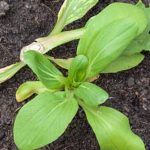During historical periods, Victory Gardens played a crucial role in promoting self-sufficiency and resilience among communities. These gardens, often found in urban and suburban areas, were not only sources of fresh produce but also symbols of solidarity and patriotism.
A key aspect of Victory Gardens was the cultivation of vegetables to support the war effort and reduce pressure on the food supply chain. In particular, vegetables grown in Victory Gardens became essential staples for families looking to supplement their diets during challenging times.
The legacy of Victory Gardens extends beyond their historical significance, as the practice of growing one’s own vegetables continues to be relevant today. The benefits of cultivating a Victory Garden are numerous, ranging from access to fresh and nutritious produce to the satisfaction of knowing where your food comes from. By planning and designing your own Victory Garden space, you can take control of your food supply and contribute to a more sustainable lifestyle.
As we delve into the world of Victory Gardens, we will explore popular vegetables that thrive in these gardens, such as tomatoes, carrots, and green beans. Understanding the seasonal planting schedule for these crops is crucial for optimal growth and harvest.
Additionally, maintaining and caring for your vegetables is essential for a successful Victory Garden. By following proper watering techniques, implementing effective pest control measures, and staying on top of weeding tasks, you can ensure a thriving garden filled with an abundance of fresh vegetables.
Benefits of Growing Your Own Vegetables
One of the key advantages of cultivating your own vegetables in Victory Gardens is the ability to have a direct impact on your food source. By growing your own vegetables, you have full control over the cultivation process, from choosing seeds to harvesting.
This hands-on approach allows you to ensure that your produce is free from harmful pesticides and chemicals, promoting a healthier lifestyle for you and your family. Additionally, by growing your own vegetables, you can save money on grocery bills while enjoying the satisfaction of producing your own food.
Another significant benefit of Victory Gardens is the opportunity to reduce your carbon footprint. By growing vegetables in your own garden, you are decreasing the need for transportation and packaging associated with store-bought produce. This environmentally friendly practice contributes to sustainability efforts by minimizing carbon emissions and waste production. Additionally, Victory Gardens promote biodiversity by supporting local ecosystems and reducing reliance on large-scale agricultural practices that can harm the environment.
Furthermore, cultivating vegetables in Victory Gardens provides a valuable learning experience for people of all ages. Whether you are a seasoned gardener or new to gardening, tending to a Victory Garden offers hands-on education about plant life cycles, soil health, and sustainable practices.
This knowledge can be passed down through generations, fostering a deeper connection to nature and promoting self-sufficiency skills. Ultimately, growing vegetables in Victory Gardens not only benefits individuals but also communities as a whole by encouraging healthy living practices and fostering a sense of unity through shared knowledge and resources.
Planning Your Victory Garden
Assessing Your Space
Before digging into the ground, take some time to assess the space you have available for your Victory Garden. Consider factors such as sunlight exposure, soil quality, access to water source, and any potential obstacles like trees or structures that may affect plant growth. It’s crucial to choose a spot that receives at least 6-8 hours of sunlight per day for most vegetable crops.
Designing Your Layout
Once you’ve identified the best location for your garden, it’s time to lay out the design of your Victory Garden. Consider factors like spacing between rows and plants, accessibility for watering and weeding, and any support structures needed for climbing plants like tomatoes or cucumbers. Make sure to plan out where each type of vegetable will be planted based on their specific sun and soil requirements.
Utilizing Raised Beds or Containers
If you have limited space or poor soil quality in your backyard, consider using raised beds or containers for your Victory Garden. Raised beds can provide better drainage and easier maintenance while containers offer versatility and mobility if you need to move your garden around. Both options allow you to control the soil quality more effectively and can be great solutions for urban gardening or small spaces.
By following these tips and advice for planning and designing your Victory Garden space, you can set yourself up for a successful growing season with an abundant harvest of fresh vegetables grown right in your backyard. Remember to tailor your garden layout to suit your individual needs and preferences while keeping in mind the importance of proper sunlight, soil quality, and maintenance practices for healthy plant growth. Happy gardening.
Popular Vegetables to Grow in Victory Gardens
One of the most gratifying aspects of maintaining a Victory Garden is being able to grow your own vegetables. By cultivating your vegetables, you not only ensure a fresh supply of produce but also enjoy the satisfaction of knowing exactly where your food comes from. Some popular vegetables to consider growing in your Victory Garden include tomatoes, carrots, and green beans, all of which are versatile and relatively easy to cultivate.
Tomatoes are a staple in many Victory Gardens due to their versatility and delicious flavor. They can be grown in various sizes and colors, from cherry tomatoes perfect for snacking to beefsteak tomatoes ideal for sandwiches and salads. Carrots are another favorite among gardeners as they are rich in nutrients and can be enjoyed raw or cooked in a variety of dishes.
Their vibrant colors add visual appeal to any garden space. Green beans thrive in Victory Gardens as they are easy to grow and provide a bountiful harvest throughout the season. Their crisp texture makes them a popular choice for stir-fries, salads, and side dishes.
In addition to these common favorites, Victory Gardens offer the opportunity to experiment with an array of vegetables suited to your climate and preferences. From leafy greens like lettuce and spinach to root vegetables like radishes and beets, there is no shortage of options when it comes to choosing what to plant.
Regardless of the specific vegetables you choose, the act of growing your own produce can be rewarding both physically and mentally, promoting self-sufficiency and sustainability in your daily life.
| Vegetable | Description |
|---|---|
| Tomatoes | Versatile fruits that come in various sizes and colors |
| Carrots | Nutrient-rich root vegetable available in different vibrant colors |
| Green Beans | Easy-to-grow vegetable with a crisp texture perfect for various dishes |
Seasonal Planting in Victory Gardens
Seasonal planting is a crucial aspect of ensuring a successful and productive Victory Garden. Knowing the best times to plant different vegetables can make a significant difference in their growth and overall yield. By following a seasonal planting schedule, you can maximize the potential of your garden and enjoy a bountiful harvest throughout the year.
To help you plan your Victory Garden effectively, here are some guidelines on the best times to plant popular vegetables:
- Tomatoes: Start seeds indoors 6-8 weeks before the last frost date in your area. Transplant seedlings outdoors after all danger of frost has passed.
- Carrots: Directly sow carrot seeds in early spring or late summer for a fall harvest. Make sure to keep the soil consistently moist for optimal germination.
- Green Beans: Plant green bean seeds directly in the garden once the soil has warmed up to at least 60°F. Successive plantings every 2-3 weeks will ensure a continuous harvest throughout the season.
By aligning your planting schedule with the specific needs of each vegetable crop, you can create a well-rounded and diverse Victory Garden that provides fresh produce from spring through fall. Additionally, consider companion planting techniques to maximize space utilization and promote healthier growth among different vegetable varieties.
Remember to take into account your local climate and growing zone when planning your seasonal planting schedule. Consulting resources such as planting calendars or reaching out to local gardening experts can provide valuable insights tailored to your specific region. With proper timing and care, you can optimize your Victory Garden for success and enjoy an abundance of homegrown vegetables throughout the year.
Maintenance and Care for Vegetables in Victory Gardens
Maintaining and caring for your vegetables in Victory Gardens is crucial to ensure a bountiful harvest. Proper watering, weeding, and pest control are essential tasks that can help your plants thrive and produce quality vegetables. Here are some tips to keep your Victory Garden in top shape:
- Watering: Adequate watering is vital for the health of your vegetables. Different plants have varying water requirements, so it’s essential to know the needs of each crop. Generally, vegetables grown in Victory Gardens need about 1-2 inches of water per week, either from rainfall or irrigation. Water deeply and less frequently to encourage strong root growth.
- Weeding: Weeds compete with your vegetable plants for nutrients, water, and sunlight. Regular weeding is necessary to prevent weeds from overtaking your garden. Pull weeds by hand or use mulch to suppress their growth. Be careful when using tools like hoes around vegetable plants to avoid damaging their roots.
- Pest Control: Protecting your vegetables from pests is a key aspect of maintenance in Victory Gardens. Monitor your plants regularly for signs of pest infestation such as holes in leaves, chewed stems, or discolored foliage. Implement strategies like planting companion plants that deter pests, using organic pesticides sparingly, and attracting beneficial insects like ladybugs to keep harmful pests at bay.
By following these maintenance tips for watering, weeding, and pest control in your Victory Garden, you can ensure that your vegetables grow healthily and abundantly throughout the growing season. With proper care and attention, you will be rewarded with a plentiful harvest of fresh and delicious produce straight from your own backyard. Remember that nurturing your vegetables not only benefits you but also contributes to the sustainability of community food sources through the concept of Victory Gardens.
Harvesting Your Vegetables
When it comes to reaping the rewards of your hard work in the Victory Garden, knowing when and how to harvest your vegetables is crucial for obtaining the freshest and most flavorful produce. Each type of vegetable has its own optimal harvesting time and method, ensuring that you get the best results from your garden efforts.
Harvesting Timing
Knowing when to harvest your vegetables is key to enjoying their peak freshness and taste. For example, tomatoes should be picked when they are fully ripe on the vine but before they become overripe and mushy. Carrots are best harvested when they reach a size suitable for eating, typically around 1 inch in diameter. Green beans should be picked while still young and tender, before they become tough and stringy.
Harvesting Techniques
Different vegetables require varying harvesting techniques to ensure minimal damage and maximum flavor retention. For instance, leafy greens like lettuce should be cut at the base of the leaves using a sharp knife or scissors to promote regrowth for future harvests.
Root vegetables such as radishes can be gently pulled from the soil, being careful not to break or damage them in the process. Additionally, some crops like squash may need to be cut from the vine rather than pulled off by hand.
Storing Your Harvest
Once you have harvested your fresh vegetables from the Victory Garden, proper storage is essential to maintain their quality and extend their shelf life. Many vegetables can be stored in a cool, dark place with good ventilation, such as a root cellar or refrigerator. Some produce may benefit from being blanched and frozen for longer preservation. Storing herbs like basil in a glass of water on the countertop can keep them fresh for longer periods as well.
By following these guidelines for harvesting your vegetables from the Victory Garden, you can enjoy the freshest produce possible while reaping the benefits of your gardening efforts. Experimenting with different harvesting techniques and storage methods can help you make the most of your homegrown bounty throughout the growing season.
Enjoying the Fruits of Your Labor
Vegetables grown in victory gardens offer more than just sustenance; they provide a canvas for culinary creativity and experimentation. From fresh tomatoes to crisp green beans, the produce from your Victory Garden can inspire a wide range of delicious dishes.
One popular dish that celebrates the bounty of victory garden vegetables is a classic ratatouille, combining eggplant, zucchini, bell peppers, and tomatoes. This flavorful stew can be enjoyed on its own or as a side dish with grilled meats or crusty bread.
Another fantastic way to enjoy the vegetables from your Victory Garden is by creating vibrant salads bursting with color and flavor. Mix fresh greens with cherry tomatoes, cucumbers, carrots, and radishes for a refreshing side dish that pairs well with any meal. You can also get creative with homemade dressings using herbs like basil, parsley, or dill from your garden to elevate the flavors even further.
For those with a sweet tooth, incorporating vegetables into desserts can be both surprising and delightful. Zucchini bread moistened by grated zucchini adds depth to this classic treat, while carrot cake topped with tangy cream cheese frosting is always a crowd-pleaser. With the diverse array of vegetables grown in Victory Gardens, the possibilities for culinary exploration are endless.
| Recipe | Main Ingredients |
|---|---|
| Ratatouille | Eggplant, Zucchini, Bell Peppers, Tomatoes |
| Fresh Garden Salad | Greens, Cherry Tomatoes, Cucumbers, Carrots, Radishes |
Community and Sustainability
During historical periods, Victory Gardens have served not only as a means of supplementing food supplies during times of war or economic hardship but also as a symbol of resilience, community spirit, and self-sufficiency. These gardens have played a significant role in promoting sustainability by encouraging individuals to grow their own vegetables and reduce their dependency on store-bought produce.
The act of cultivating vegetables grown in Victory Gardens has fostered a sense of connection to the land and a deeper appreciation for the effort that goes into producing food.
By engaging in the practice of growing your own vegetables in Victory Gardens, individuals can experience firsthand the benefits of fresh, homegrown produce. From tomatoes bursting with flavor to crisp carrots straight from the soil, there is a satisfaction in harvesting fruits and vegetables that you have nurtured from seed to plate.
This connection to the food we eat can lead to healthier eating habits and a greater understanding of where our food comes from, ultimately promoting self-sufficiency and reducing food waste.
Additionally, Victory Gardens have the power to bring communities together through shared experiences and resources. Whether it’s swapping surplus zucchinis with neighbors or collaborating on a community garden project, these gardens create opportunities for people to connect over a common goal.
Through this communal effort, not only are social bonds strengthened, but sustainable practices are also shared and promoted. The legacy of Victory Gardens lives on not just in the produce harvested but in the sense of unity and resilience they instill in individuals and communities alike.
Frequently Asked Questions
What Vegetables Are in a Victory Garden?
Victory Gardens during World War II typically included a variety of vegetables such as tomatoes, lettuce, peppers, carrots, potatoes, beans, squash, and peas. These gardens were meant to supplement the food supply and boost morale during the war effort.
What Did They Grow in Victory Gardens?
In Victory Gardens, people grew a wide range of fruits and vegetables to help alleviate food shortages during World War II. Some of the popular crops grown included tomatoes, cucumbers, cabbage, spinach, radishes, and various herbs. These homegrown produce not only provided sustenance but also promoted self-sufficiency among civilians.
How Many American Vegetables Came From Victory Gardens 1945?
Victory Gardens in 1945 played a significant role in providing fresh produce to Americans during wartime rationing. The exact number of vegetables produced from these gardens is difficult to quantify accurately.
However, it is estimated that millions of pounds of vegetables were harvested from Victory Gardens across the United States in 1945 alone. This immense contribution helped support families and communities during a time of scarcity and increased demand for food resources.

If you’re looking to get into vegetable gardening, or are just looking for some tips on how to make your current garden better, then you’ve come to the right place! My name is Ethel and I have been gardening for years. In this blog, I’m going to share with you some of my best tips on how to create a successful vegetable garden.





